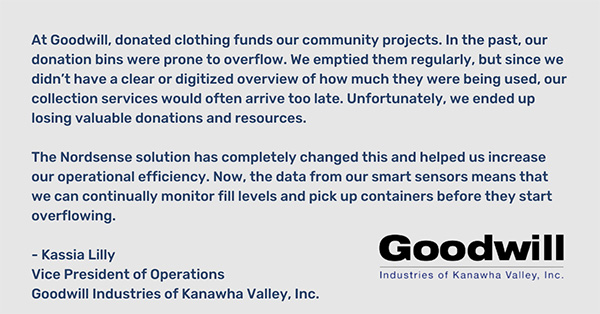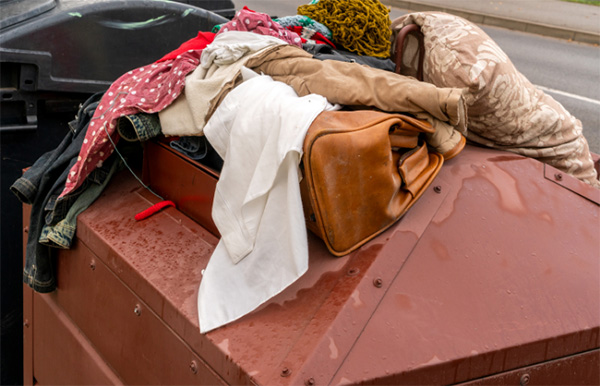Clothing banks are an easy and convenient way to sustainably get rid of unwanted textiles. Based on the principles of a circular economy, clothing banks are all about reusing, recycling, and sharing resources. The US Environmental Protection Agency reports that Americans generate 17 million tons of textile waste a year. A shocking 11.3 million tons gets sent to landfill. However, clothing banks can help reduce the amount of textile going to landfill and make a positive environmental impact.
But around 75% of clothing containers are serviced at the wrong time. Collections that occur too early lead to higher running costs and a larger carbon footprint due to unnecessary vehicles on the road. Collections that occur too late lead to overflowing banks, contaminated textiles, and a loss of resources. Due to the highly unpredictable nature of textile recycling, more and more clothing bank operators are turning to smart sensors as a way of improving their collection efficiency.

Cost- and Carbon-Efficient Clothing Banks
Our findings from the USA show that approx. 62% of clothing containers are picked up too early. In the UK, 67% of textile collections are happening at the wrong time. This is due to an inefficient and outdated way of dealing with clothing waste.
Many clothing containers operate on static collection service schedules. This means that clothing banks are emptied according to a fixed timetable at regular intervals. Collection trucks are sent out regardless of how often people are actually using the bins. Trucks risk being greeted by near-empty bins. This is costly and inefficient for clothing bank operators.
Smart sensors can help you transition to more modern and efficient textile waste collection. Smart sensors are small IoT devices that are fitted inside clothing banks. They measure various data points inside of the container. You can then follow this data on an online platform. And it all happens in real-time. The platform provides actionable insights for improving collection routes. Optimization recommendations include how to cut down on costs, reduce the number of vehicles on the road and fuel consumed, and collect clothing in a more efficient manner.
Increasing Resource Efficiency
It’s no secret that clothing banks are prone to overflowing and late collection services. Our research in the US highlights that it’s not uncommon to see clothing containers overflowing for up to three days. In Germany, clothing containers are often overflowing for up to two days before being picked up.
When clothing bins are full, people leave their donations on the street next to the bin. Unfortunately, this renders them unusable. Textiles are deemed contaminated when left outside in the open and subjected to all kinds of weather conditions. This means that they cannot be recycled, reused, or resold. But these donations are a main source of funding for non-profit projects driven by the organizations behind clothing banks.

A smart waste management solution can help tackle this issue and help clothing banks gather more textile resources. Operators can check the fill levels of clothing banks in real-time and carry out collection services before bins start overflowing and it’s too late to save the donations. In this way, you can gain extra resources for their fundraising work.
According to assessments by The Danish Salvation Army, they lose around 20-25% of resources due to overflowing containers and late collection services. Picking up clothing banks at the right time and avoiding late collections could save this charity around USD 300,000 – 750,000 lost in funding for charitable work.
Improving Clothing Banks’ Public Image
Unfortunately, residents often complain about clothing banks. Their bulky structure means that they are not exactly regarded as a fashionable addition to urban areas. And unfortunately, overflowing textile bins with clothes strewn around them and in the street is a common sight. Clothing bins are not only an eyesore. They are also an issue of hygiene.
Increasing resident complaints and a poor public image mean that municipalities are reluctant to authorize certain locations for clothing banks. Busy city center locations are optimal in terms of increasing textile recycling rates due to the convenience factor. But due to the overflowing tendencies and dissatisfied locals, clothing banks often have to settle for more peripheral locations.

A data-driven approach to textile collection services can help you guarantee municipalities and local waste authorities that your clothing containers will not overflow. All while keeping the number of vehicles on the road and carbon emissions to a minimum. Real-time data on clothing bins can help you observe how frequently people donate unwanted clothing and adjust collection services accordingly.
Optimize Your Clothing Banks with Smart Sensors
Textile recycling patterns and donation trends are highly unpredictable, which is why clothing bins are prone to overflow. Assumptions and historical standards simply don’t cut it anymore. Data is the key to maintaining efficient clothing banks. Smart sensors can help you service clothing containers before they start to overflow and before donations become contaminated. That way, you can get the most out of donated resources and make a greater impact in your charitable projects.
Find Out More About Installing Smart Sensors in Your Clothing Bins.
